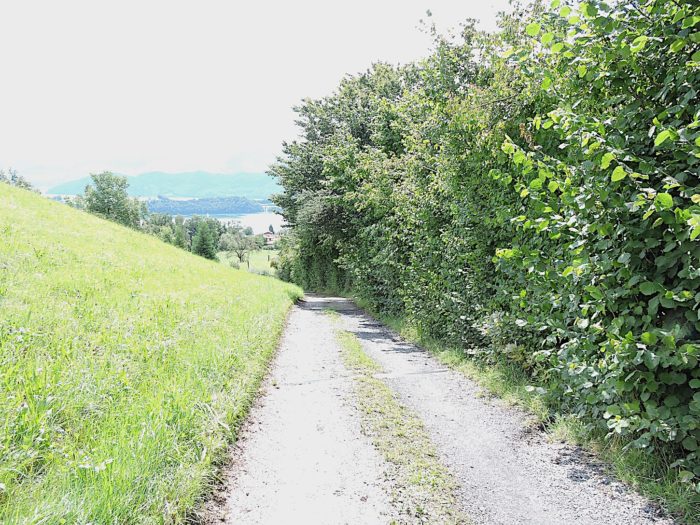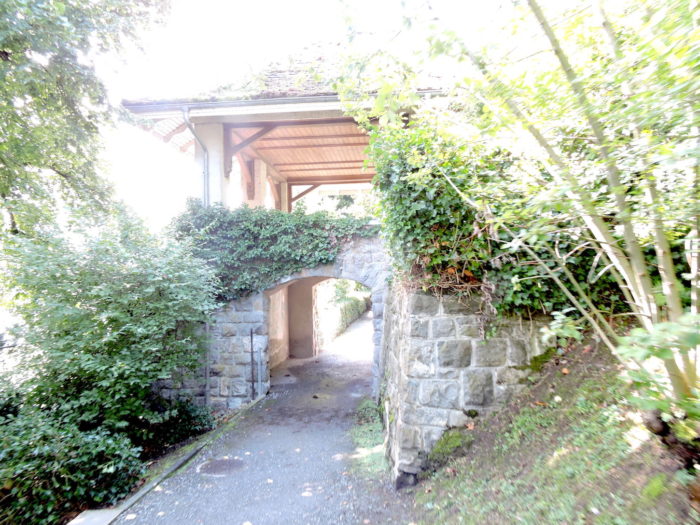Luzern, the epitome of Swiss tourism
DIDIER HEUMANN, ANDREAS PAPASAVVAS

We divided the course into several sections to make it easier to see. For each section, the maps show the course, the slopes found on the course, and the state of the route (paved or dirt roads). The courses were drawn on the « Wikilocs » platform. Today, it is no longer necessary to walk around with detailed maps in your pocket or bag. If you have a mobile phone or tablet, you can easily follow routes live.
For this stage, here is the link:
https://fr.wikiloc.com/itineraires-randonnee/de-kussnacht-a-lucerne-gare-par-la-via-jacobi-98-waldstatterweg-135671220
|
Not all pilgrims are necessarily comfortable using GPS or navigating routes on a mobile device, and there are still many areas without an internet connection. For this reason, you can find several books on Amazon dedicated to the major Via Jacobi 4 route, which runs through the heart of Switzerland and over the Brünig Pass. The first guide leads pilgrims through the German-speaking part of Switzerland up to Fribourg, while the second continues through French-speaking Switzerland to Geneva. We have also combined these two books into a compact, lighter, and highly practical version. While the descriptions have been slightly condensed, they remain detailed enough to guide you step by step along the way. Recognizing the importance of traveling light, this latest edition has been designed to provide only the essentials: clear and useful information, stage by stage, kilometer by kilometer. The stages have been carefully adjusted to ensure accessibility and alignment with available lodging options. These books go beyond simple practical advice. They guide you kilometer by kilometer, covering all the crucial aspects for seamless planning, ensuring that no unexpected surprises disrupt your journey. But these books are more than just practical guides. They offer a complete immersion into the enchanting atmosphere of the Camino. Prepare to experience the Camino de Santiago as a once-in-a-lifetime journey. Put on a good pair of walking shoes, and the path awaits you.
|

|
 |
If you only want to consult lodging of the stage, go directly to the bottom of the page.
The canton of Luzern, like a sentinel of Swiss history, has from the dawn of 1332 woven its roots deeply into the fertile soil of the nascent Confederation, then composed of the brotherly cantons of Schwyz, Uri, and Unterwalden. The Lake of the Four Cantons (Lake Luzern), like a jewel celebrating the nascent unity, emerged as the cradle of the Swiss nation, while the opening of the Gotthard axis, a true artery for the transit of goods, propelled Luzern to the status of a vital crossroads between the north and south of Europe. Over the centuries, with the gradual joining of other cantons, Luzern aspired to the title of « Swiss capital, » a dream realized without great difficulty thanks to its central position and the unwavering support of the pioneering cantons of the confederation. However, during these tumultuous times, Switzerland floated without an official capital. Then came the Reformation, sowing the seeds of change by the hand of Ulrich Zwingli in 1523. Some cantons, intrigued, embraced this new faith, with Zurich at the forefront of this reformist movement. Tension between Catholics and Protestants escalated into open conflict, embodied by the Wars of Kappel, which saw Zwingli fall in battle. The peace, though signed, only sealed a division, subtly favoring Catholics while leaving the door open to incessant ideological struggle, where Protestants, advocating for centralization of power, gradually gained ground.
Luzern, faithful to its Catholic heritage, still preserves it today like a treasure. Between 1845 and 1847, it rose at the head of a secessionist coalition, the Sonderbund, gathering seven conservative Catholic cantons determined to protect their interests against the rising tide of centralization. This fraternity was a response to the rise of the Radical Party, carrying a decidedly anti-Catholic agenda. In a swift campaign of 27 days, the forces of the Sonderbund, though outnumbered and outgunned, were defeated by the troops of General Dufour, a precursor figure of the Red Cross, in a confrontation sparing fewer than a hundred lives. The Radicals, victorious, established their rule over all cantons. Luzern then saw its convents banned and pillaged, its houses ransacked, while General Dufour, like a beacon in the storm, managed to contain the anarchy. In 1848, as revolution engulfed Europe, Switzerland, like the phoenix, rose under a new constitution that forged the federal state, tolling the bell for cantonal autonomy. The Jesuits, especially those of Luzern, were relegated to the margins of society, then expelled. Luzern, the magnificent, had to yield its symbols of prestige, leaving Bern as the political capital and Zurich as the economic capital. Tourism remained, a domain in which the people of Luzern, far from resigning themselves, excelled. Sumptuous palaces sprung up on the shores of the lake, while steamboats, in an elegant choreography, majestically glided under the benevolent gaze of the Rigi and Pilatus, heralding the era of mass tourism long before the arrival of travelers from around the world.

Difficulty level : Today’s stage is distinguished by its moderate elevation changes (+373 meters/-366 meters), offering a mostly gentle route, except for the presence of a significant bump in its first half, where some steep slopes may be encountered. Once you reach the lake at Meggen, the path becomes a stroll, an invitation to contemplation.
State of the Via Jacobi: In this stage, you will walk a bit more on roads than on paths, but not by much, which is often the case:
- Paved roads: 9.3 km
- Dirt roads : 8.3 km
Sometimes, for reasons of logistics or housing possibilities, these stages mix routes operated on different days, having passed several times on these routes. From then on, the skies, the rain, or the seasons can vary. But, generally this is not the case, and in fact this does not change the description of the course.
It is very difficult to specify with certainty the incline of the slopes, whatever the system you use.
For those seeking « true elevations » and enthusiasts of genuine altimetric challenges, carefully review the information on mileage at the beginning of the guide.

Section 1: In the meadows above Küssnacht

Overview of the route’s challenges: steep slopes along the way.

|
Over Lake Luzern, today’s weather brings rain, a common occurrence in the region. The perpetual rain weaves its gray fabric, enveloping the waters and mountains in a melancholic embrace. The Via Jacobi 98 stretches forth like a sentinel through the urban fabric, making its way to the lake, yearning for the proximity of the station with great determination.
|
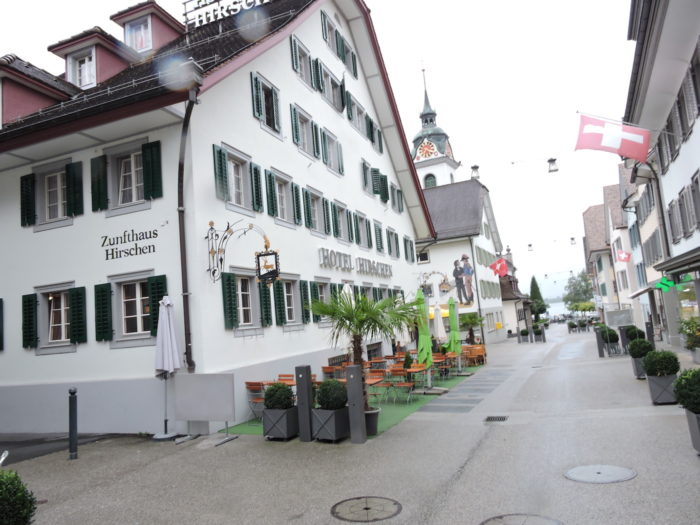 |
 |
|
This route, a vibrant artery of the city, winds through a park embracing the shore near the church. Raindrops vie with the silvery shimmer of the lake.
|
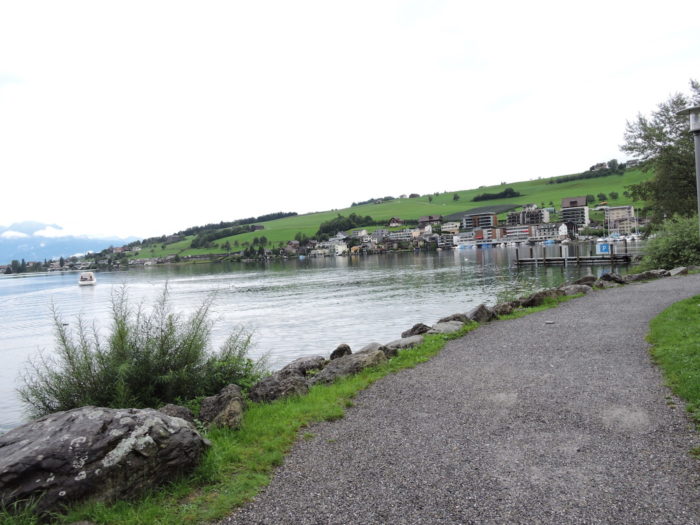 |
 |
| Beyond the marina, where boats seldom rock to the rhythm of the waves, the Via Jacobi plunges into the darkness of a tunnel, as if diving into the belly of the earth, before emerging towards its ultimate goal: the station. |
 |
 |
Here, the road transforms into a mischievous stone serpent, playing hide and seek with travelers. It undulates from tunnel to tunnel, ramp to ramp, in a complex and fascinating ballet, seeking to emerge triumphantly on the other side of the station, as if to reveal its victory over the constraints of the world built by man.
|
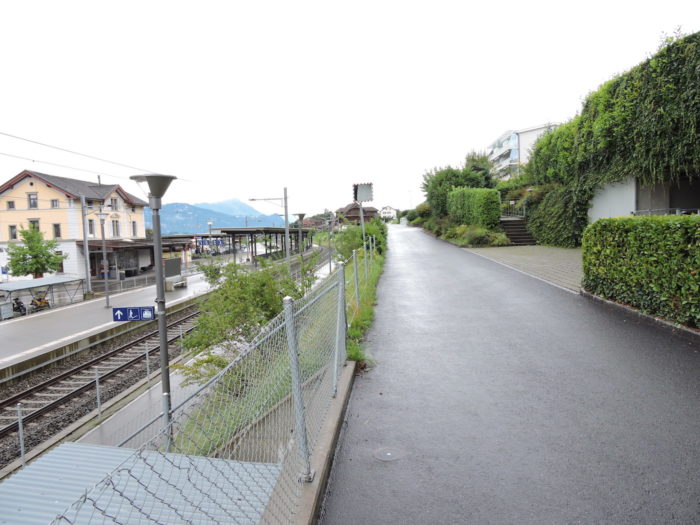 |
 |
| Barely does the station recede into the background when a narrow road climbs before you, resembling a delicate ribbon boldly unwinding through meadows and farms. It climbs ambitiously toward the sky, winding around the hill with unsuspected grace, as if aspiring to touch the clouds. |
 |
 |
| On this rugged road, the green grass, almost unreal in its hue, is not alone. Occasionally, some fruit trees stand, isolated but proud, like solitary sentinels amidst a sea of greenery, their branches laden with promises. |
 |
 |
| Farms, like stone and wood sentinels, boldly ascend the slope, defying gravity. From this ascent, the gaze can sweep towards Küssnacht and its lake, capturing also in a fleeting moment the triumphant arrival of a train on the Rigi, up there at the mountain summit, in a peaceful world. |
 |
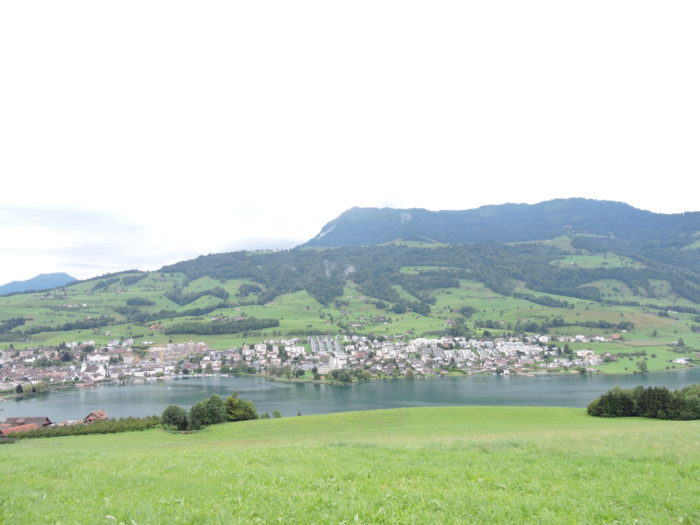 |
| As you ascend, the slope becomes less steep, offering respite to travelers and buildings, which, now closer together, seem to gather to share tales and legends of the landscape. Strangely, the cattle, an essential actor in these lands, remain absent, as if, for a moment, the earth had decided to hold its breath. |
 |
 |
| A majestic sign, a large and imposing cross, stands at the roadside like a beacon guiding lost souls, adorned somewhat like an Indian totem. It heralds a change of direction: Almig is not your destination, although you are surrounded by the very essence of this hamlet, embodied by the scattered farms in the landscape. |
 |
 |
| Here you are again in the canton of Schwyz, where farms boast a noble simplicity, without pretensions of grandeur or extravagant decoration. Yet, geraniums, bursts of color and life, testify to a discreet joy, typical of this Alemannic Switzerland where beauty lies in authenticity and restraint. |
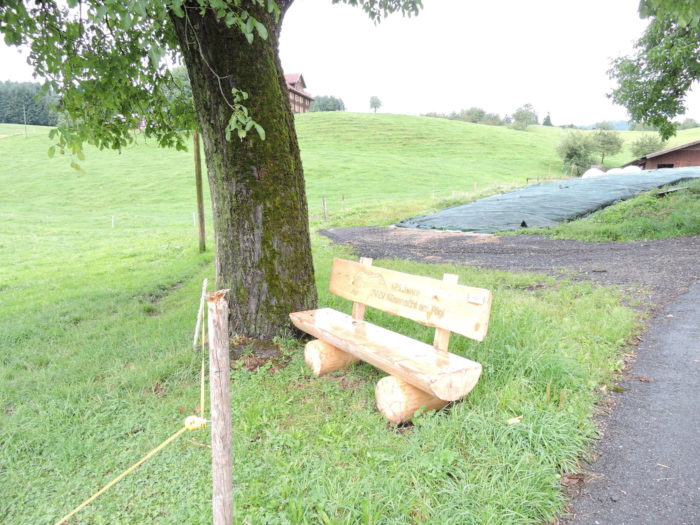 |
 |
| As you progress, the slope regains its splendor, rising with renewed vigor beneath your feet. The road, like a faithful companion, continues to flirt with the contours of the farms, embracing the terrain with natural ease. |
 |
 |
| Soon, it brushes against the edges of a forest populated with spruces, where time seems to stand still. These wooden sentinels, reaching towards the sky, watch over the road with silent dignity, guardians of a forgotten world. There, in the meadows, a haystack stands like an Indian tent. |
 |
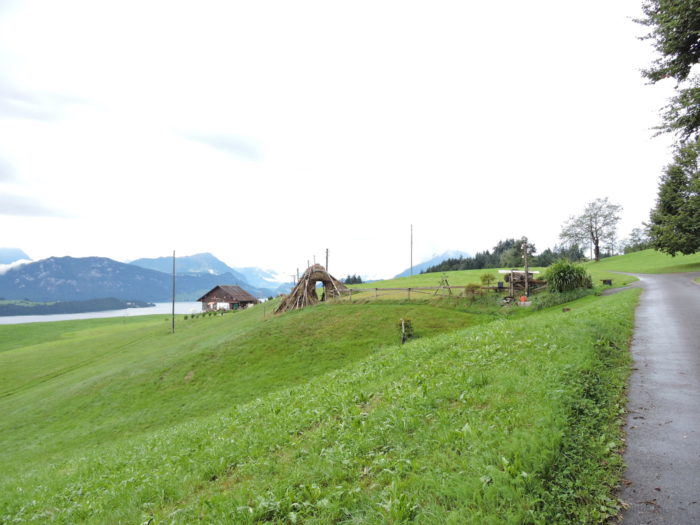 |
| Then, space opens up, revealing a stretch where the beauty of the grass, in its simplicity, strikes the mind with the force of a masterful brushstroke on a blank canvas. Harmony reigns as the absolute mistress, in a painting where every blade of grass contributes to the majesty of the whole. |
 |
 |
| The road, in its relentless quest for new horizons, soon leads you into the heart of the forest. Here, a choice presents itself: to stay on the beaten path or to venture onto a trail winding through dense undergrowth and inviting clearings for contemplation. The organizers, with a touch of mischief, encourage you to choose the adventure of the less-traveled path. |
 |
 |
| Within this natural cathedral, vegetation explodes with life, a green fireworks display. Ferns, in a surge of freedom, sprawl under the benevolent gaze of beech trees, which stand proudly like ship masts conquering the waves of a green ocean. |
 |
 |
| And there, in a clearing bathed in a supernatural light, a picnic bench invites you to take a break, to sit and breathe the moment, offering a parenthesis of peace to the nature-loving traveler. |
 |
 |
Section 2: The Via Jacobi gradually descends towards the lake

Overview of the route’s challenges: routes with steep slopes.

| Descending from the clearing, where thoughts mingle with the fresh air, the forest trail reunites with its old companion, the road you had left before. The descent is gentle, embraced by the softness of the slope. The forest reveals itself in all its diversity, a living fabric composed of beeches, maples, chestnuts, and dotted with spruces, in a harmony that emphasizes the rarity of oaks in these lands, in stark contrast to French forests. |
 |
 |
| Emerging from the shaded embrace of the undergrowth, the route transforms, the beaten earth taking precedence over the asphalt, following the contours of a hillock crowned by a farm. The surrounding meadows, so perfect they could be mistaken for lawns, unfold a verdant carpet beneath your feet. |
 |
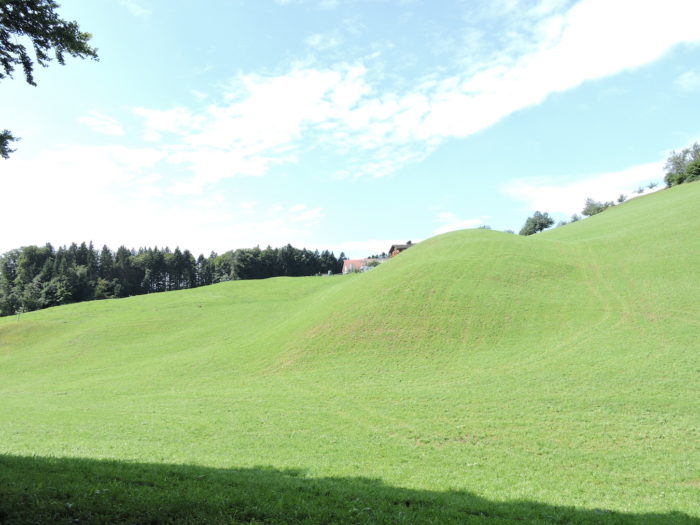 |
| Here, the gravel path seems to play with shadows and light, dancing between undergrowth and clearings, in an eternal sway that captivates the soul. |
 |
 |
| It then leads you to the haven of Wagemoos, a sanctuary of tranquility where one would dream of pitching a tent, immersing oneself in this cocoon of serenity, far from the tumult of the world. |
 |
 |
| And there, in the heart of this pastoral scene, near a sleepy pond, unveils a sports course, heir to the old VITA courses, these trails that dot Switzerland, recalling the country’s commitment to health and well-being. One cannot say how one arrives here from civilization to enjoy this sports course. In a green escape, hidden by a veil of tall grasses and wildflowers, rests a small pond, a jewel of water and calm, seeming to have escaped from a fairy tale. Around it, a space dedicated to barbecues, arranged with the attention to detail and warm hospitality that characterize the Swiss Germans so well. However, in a surprising oversight, matches have not been provided, inviting visitors to employ the paths of ingenuity to ignite their fire. |
 |
 |
This haven, in a tableau of tranquility and nature, lies against a backdrop of 2 hours and 30 minutes from Luzern, a journey that, step by step, brings you closer to urban excitement.

| Continuing its journey, the path, like a serpent of earth and leaves, boldly winds between light-bathed clearings and leafy undergrowth, where each step plunges us into an atmosphere sometimes luminous, sometimes mysteriously shaded, in a oscillation of slopes and gentleness. |
 |
 |
| Soon, the forests fade in your wake, giving way to a vast expanse of freedom. The path becomes a wide ribbon of earth with a grassy strip in the middle The meadows open before you, dotted with solitary groves that stand out against the background, like soft notes on a score of greenery. |
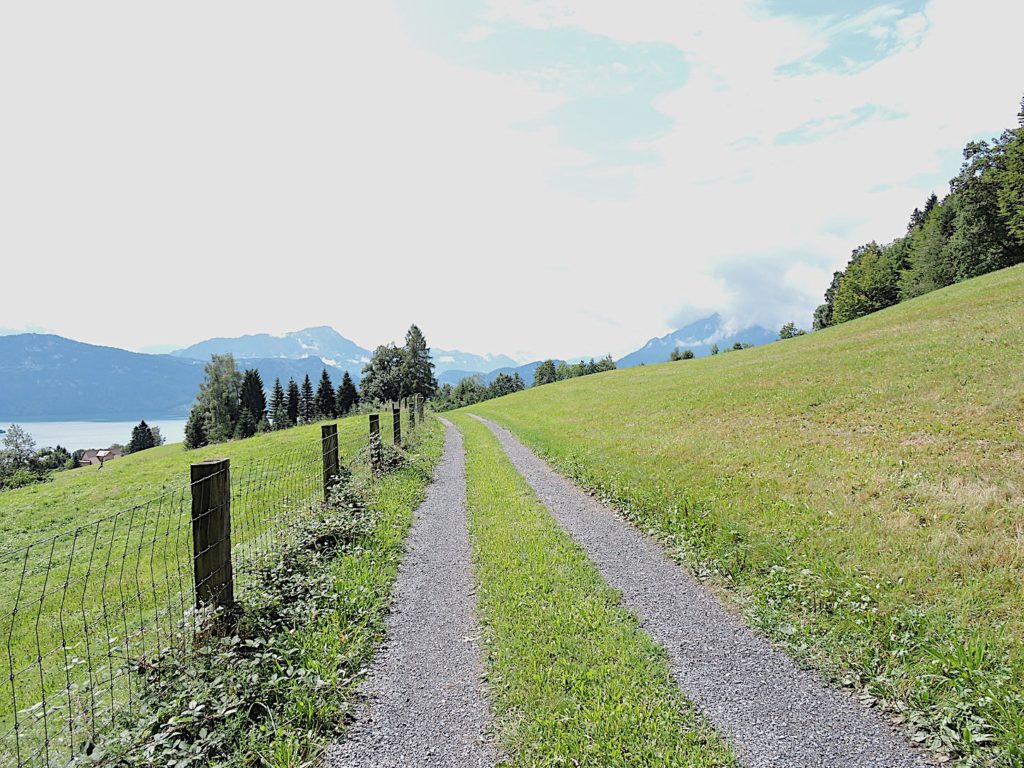 |
 |
|
Then, the path begins a steeper descent, sliding towards the first traces of civilization. Below, the lake unfolds, a liquid mirror under the majestic shadows of Mount Rigi, in a silent dialogue between water and stone.
|
 |
 |
And here come the first silhouettes of houses, with their shingled facades and tiled roofs, a return to the world of men, where each building tells a story, a return to the nest.
|
 |
 |
| Here, you can advance on the asphalt or on the grass. The panorama widens, embracing the lake in its vastness, offering a view that stretches to Vitznau, where the waters meet the Ober Nas escarpment. This ridge line, once a bastion of the Swiss army during the tumults of the last war, stands as a silent witness to history, watching over the peaceful waters of the lake. |
 |
 |
| Further down, it’s a small road descending with a daring slope towards the village of Tchädigen. It’s a weaving of nature and civilization, amidst rustic wooden farms perched on the hills. |
 |
 |
Here, the paths multiply, offering choices to the wandering soul. The Via Jacobi 98, the heart of Luzern remains a mere 2 hours and 30 minutes away, an invisible link that ties you to urban excitement. Here, you find yourself at the border of the cantons of Schwyz and Luzern.

| From here, the journey continues on the sidewalk, companion to the asphalt road winding towards the lake, an Ariadne’s thread laid on the shores of time. |
 |
 |
| Further on, the road follows the meanders of a small stream, a murmuring companion for the traveler, a liquid guide leading the descent towards more intimate horizons. |
 |
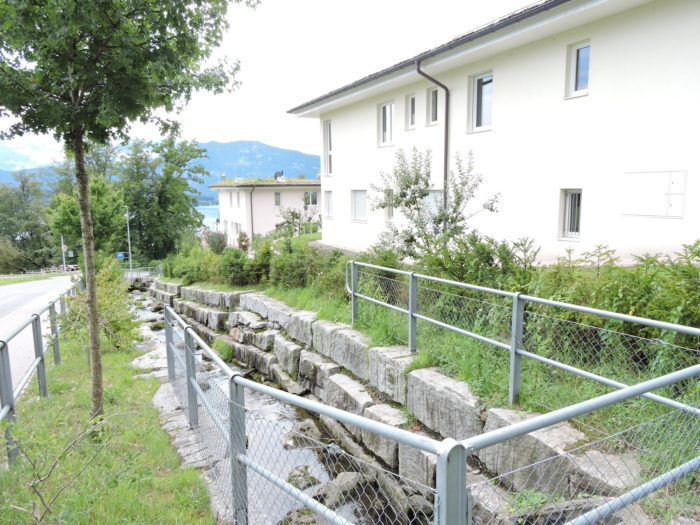 |
| The Via Jacobi goes to find the cantonal road Küssnacht-Luzern, in the heart of the village of Gottlieben. There, the village church looms, a proud and welcoming silhouette, marking the end of the descent, near the lake. |
 |
 |
Section3 : The long crossing of Meggen

Aperçu général des difficultés du parcours It’s far from flat, even though you walk along the lakeshore.

| After crossing the cantonal road with determined steps, the route plunges into the descent, crossing Gottlieben with fluid elegance, as if a dancer were descending a spiral staircase. |
 |
 |
| Behind the church and some beautiful farmhouses, a path unfolds, a silent invitation to follow the silver thread of the railway into the unknown. The path, a faithful companion to the traveler, slips between the rails, tracing with its gaze the metallic route that stretches straight ahead. |
 |
 |
| For a moment, it runs alongside the tracks, capturing the steady rhythm of trains heading towards the horizon, before subtly veering to the other side, drawing closer to the lake, like a lover approaching his beloved. |
 |
 |
Then, nearing an intersection, a choice presents itself. Where one could follow the path leading to the Meggen station, the Via Jacobi continues on without turning towards the center of this town of 7,500 souls, staying true to its predetermined course.

| Continuing its course, the Via Jacobi soon finds itself enveloped in a setting of luxurious villas, where winding pathways and small parks mingle in a waltz of secrets. One wonders whether these spaces are reserved for the wealthy elite or generously offered to passing travelers. It’s the mystery of Buhl Park that unfolds at your feet, an oasis of greenery amidst semi-urban splendor. |
 |
 |
| At the end of these majestic pathways, in the secrecy of a world shared between public and private, the path finally opens up to the lakeshore, where the waters stretch as far as the eye can see, like a mirror reflecting the infinite sky. |
 |
 |
| Gradually, the path moves away from Buhl Park, where opulence reveals itself in the imposing silhouettes of buildings overlooking the tranquil waters of the lake, like guardians watching over a precious treasure. |
 |
 |
Soon after, an unexpected encounter: a stream cascading with vigor, filling the air with its crystalline song. Here, in this corner of preserved nature, lies Mülital, a secret valley where the murmur of wildlife becomes more intense.

| And there, almost miraculously, a few vines grow as strangers amidst the wild beauty. |
 |
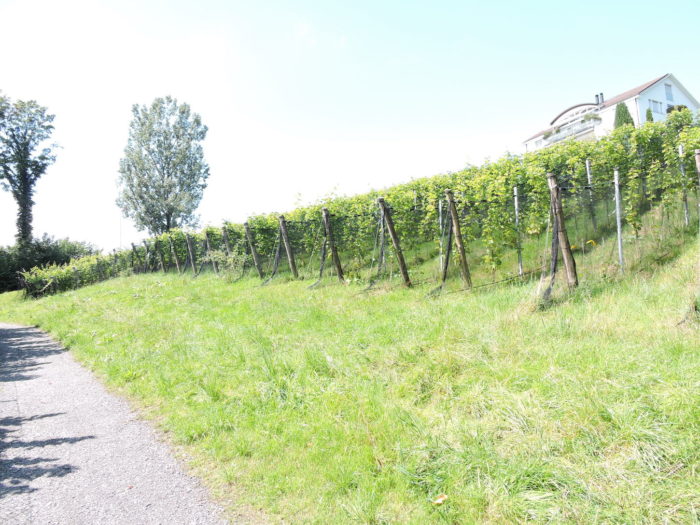 |
| The path then continues through a sparsely inhabited area, slightly elevated above the shimmering waters of the lake, amidst a maze of lush hedges. |
 |
 |
| Shortly after, the Via Jacobi takes a small road, a delicate descent to the welcoming shores of the lake, where the murmurs of the waves gently caress the shores with a tender promise of adventure. The houses, often luxurious, stand discreetly on the hills sloping towards the lake. Passing through here, one can guess that the canton of Luzern surely boasts great fortunes. |
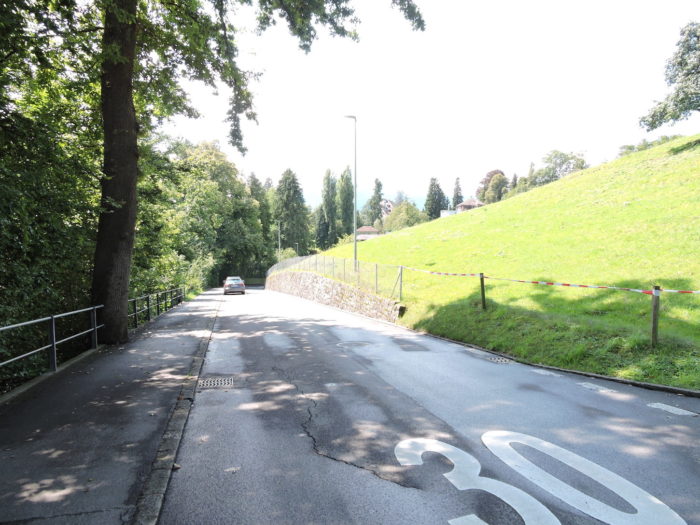 |
 |
| The route then passes by the port of Meggen, 1 hour and 50 minutes from Luzern, with a St James showing you the way, like a benevolent guide in this earthly odyssey. |
 |
 |
| An enjoyable little marina emerges here, a haven of tranquility where sailboats sway gently to the rhythm of the waves, rarely inclined to set sail. |
 |
 |

| Shortly after, it’s the actual port that unfolds before you, with its welcoming quays inviting for a pause, a moment of contemplation facing the beauty of the lake. |
 |
 |
| The route then follows Seestrasse, the peaceful lakeside road, where old houses sometimes adorned with faience shingles stand as silent witnesses to ancient history. Half-timbered facades intertwine in an architectural dance, recalling bygone eras where time seemed to stretch in infinite sweetness. |
 |
 |
From here, it’s possible to reach the center of Meggen, where the heart of local life beats, but the Via Jacobi doesn’t go there.

|
Further on, the Via Jacobi leaves Meggen on a road that moves away from the lake, like a sylph drifting from the shores to explore new horizons. In Switzerland, it’s true that generally, all regions bordering lakes are the domain of the wealthy.
|
 |
 |
However, here it’s also a region where old wooden houses, traditional farms, and modern homes blend harmoniously, suggesting enriching social diversity. Farmers have not completely dispersed their heritage yet, still attached to the nurturing land that saw them born and prosper.
|
 |
 |
You then walk further into the heart of the countryside, where even the road winds its way through a farm, illustrating this Swiss peculiarity where private and public coexist harmoniously.

The road then descends gently towards Neumatt, where villas proudly succeed one another on the hills overlooking the lake, like sentinels watching over these tranquil waters.
|
 |
 |
| At the exit of Neumatt, the dirt road takes over from the tarmac, guiding your steps on a path that oscillates above the lake, offering enchanting panoramas to those who know how to appreciate them. |
 |
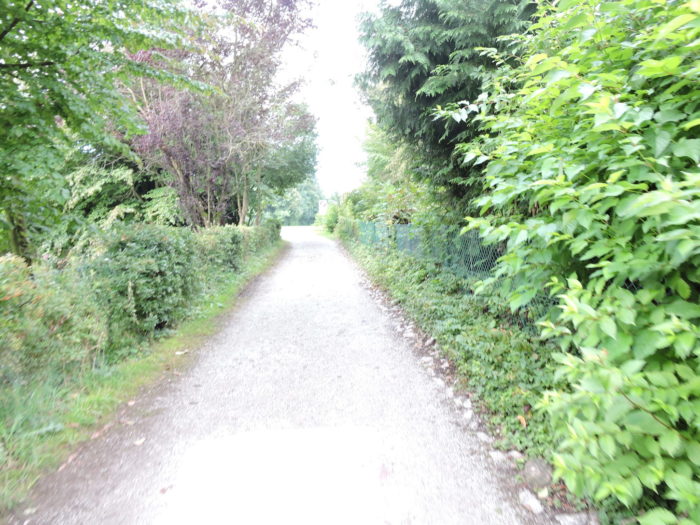 |
| The path then leads to Meggenhorn Castle, perched there like a sugar cube on the hill. The first mentions of the imposing residence date back to the 13th century. Transformed into a manorial house and mansion in the 17th century, it was later remodeled in a romantic style, reminiscent of the Loire castles. The park, enriched with a neo-Gothic chapel, completes this fairy-tale picture. Today, still in private hands, the castle and its chapel are classified as nationally significant cultural assets, offering their spaces for unique events and allowing visitors to acquire the wine, the renown of this exceptional residence. |
 |
 |
Section 4: Lakeside walk

Overview of the route’s challenges: route without any problems.

| Before you, still majestic, rises Mount Pilatus, an essential landmark of Luzern, with its famous cogwheel train climbing towards the peaks. In Luzern, tourists have the choice between Pilatus and Rigi, or even both, to immerse themselves in the splendor of the alpine panoramas. Departing in the rain, we now find ourselves under a sky of brilliant blue, where every ray of sunlight reveals a landscape filled with magic. |
 |
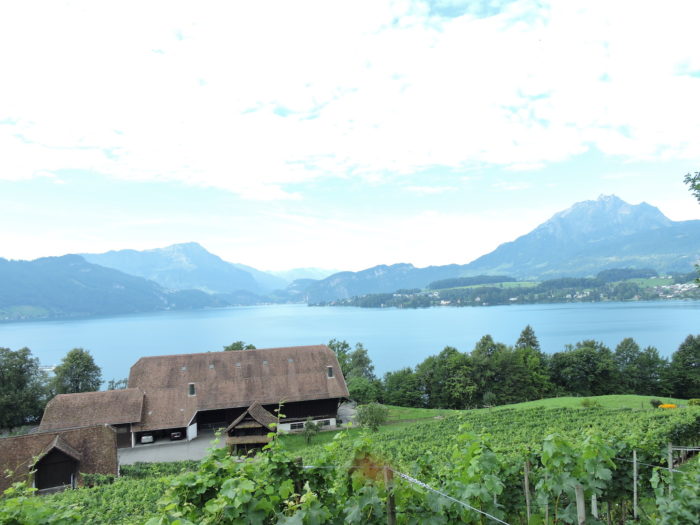 |
| From the castle, a trail gently undulates, like a snake of grass and stone, between the verdant meadows and the dwellings punctuating the landscape. |
 |
 |
| Shortly after, the narrow trail winds its way toward the railway, always accompanied by the surrounding farms. German-speaking Switzerland retains its agricultural soul, even near cities, where centuries-old traditions blend with the buzz of modern life. But the hills most often boast graceful patrician houses, hidden behind their gates, in the heart of sumptuous parks where nature blends with the elegance of architecture, offering a tableau worthy of fairy tales. |
 |
 |
| From the railway, a wider path begins its descent towards the lake, meandering between grandiose patrician houses. From there, a part of Luzern’s suburbia unfolds before your eyes, where affluent residences merge into a tranquil urban tableau. |
 |
 |
|
Soon after, the path makes its way through a dense woodland, where sunlight filters through the foliage, creating patterns of shadow and light.
|
 |
 |
And there stands before you the Hotel Hermitage, a renowned establishment in the region, whose reputation transcends even borders, marked as an essential landmark on topographic maps.

|
Shortly after, the Via Jacobi merges with the road, accompanying travelers’ steps along the way, past the discreet yet luxurious suburbia hotels.
|
 |
 |
Before long, Seeburg pier comes into view, like a jewel of old times nestled in the heart of Luzern’s long lakefront, inviting exploration of the lake’s wonders.
|
 |
 |
Here, towering majestically before you is Mount Pilatus, proudly overlooking the lake from its dizzying heights. In the distance, at the end of the bay, the city center emerges faintly, like a jewel nestled in the valley.
|
 |
 |
| Further along, the Via Jacobi traverses a peaceful waterside park under tall trees, where the yacht club stands as a testament to the locals’ passion for water sports. From this moment, you’ll only follow the lake’s meanders, letting yourself be lulled by its infinite tranquility. |
 |
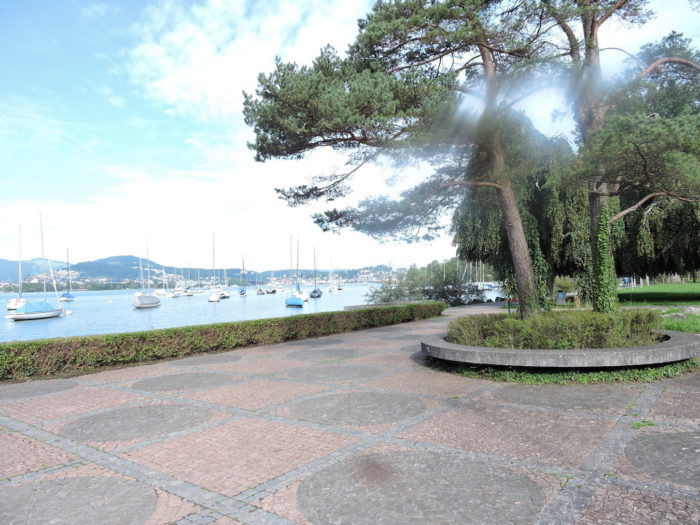 |
| Here, the shoreline stretches widely, bordered by a succession of green parks, exuding a sense of space and freedom, perfect for leisurely strolls. |
 |
 |

| Even further, lies the vast park housing the Swiss Museum of Transport, a remarkable institution applauded by the Swiss, where the history and innovation of transportation means intertwine in a captivating display. |
 |
 |
Before you, the bay gently penetrates into the hinterland, like a breath of nature entering the land, offering a soothing and enchanting spectacle.

| And the ballet of parks continues with renewed energy, from one green space to another, in a symphony of colors and scents. This lakeside walk on a sunny day is truly invigorating and sublime. Everything here exudes grandeur and cleanliness. Not a single piece of paper tarnishes the splendor of this idyllic scene. |
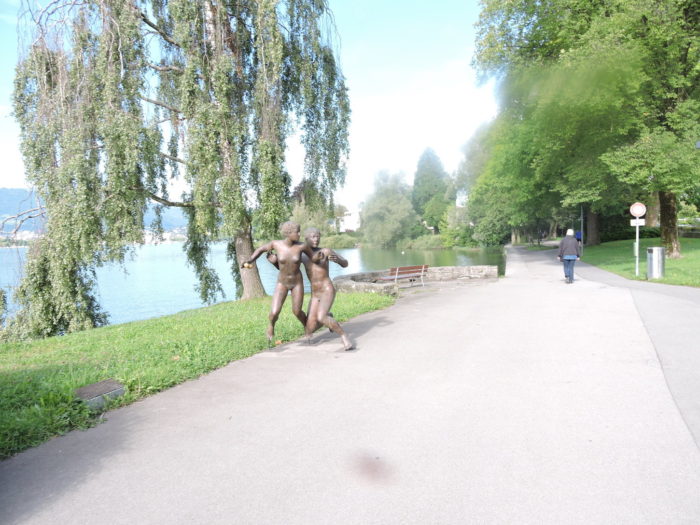 |
 |
| Further ahead, you can already distinguish the imposing silhouette of the station and the soaring spires of the cathedral proudly standing before you, bearing witness to the city’s grandeur and its millennia-old history. |
 |
 |
Section 5: Heading towards the beautiful city of Luzern

Overview of the route’s challenges: smooth sailing.

|
There is also a marina gracefully moored along the shore. Today, the lake is perfectly calm, like a smoothly polished oil painting. It’s easy to understand why, with such grace, so many foreign visitors come to discover Luzern, drawn not only by its renowned watchmaking but also by the enchanting serenity of its lakeside landscapes.
|
 |
 |
|
The pier extends peacefully in the shade of ancient trees, offering a haven of freshness to walkers marveling at the peaceful beauty surrounding them.
|
 |
 |
|
Shortly after, you set foot on the Lido, walking along the lake’s shores passing near the Seebad, these public baths where the pleasure of swimming harmoniously combines with the tranquility of the sparkling waters. Here, stands before your eyes prominently the KKL, the large modern complex near the station, a symbol of the vitality and modernity of the city.
|
 |
 |
|
Further on, the harbor looms, bustling with the constant coming and going of cruise ships and public boats diligently serving all the small towns nestled around the lake, thus offering an ideal way to discover the region from a new perspective.
|
 |
 |
|
Before you, the grand bridge majestically spans the Reuss, offering a breathtaking view of the iconic tower of the famous pedestrian bridge, the Kappelbrücke, a timeless symbol of Luzern’s history and beauty.
|
 |
 |
|
Here, you are right in the heart of the city center, near the prestigious Schweizerhof, a stone’s throw from Schwanenplatz, a high place of luxury watchmaking in Switzerland, where time seems to stand still in front of the splendor of the sparkling shop windows.
|
 |
 |
|
You will soon reach the grand bridge, often crowded with tourists and vehicles, which connects the two banks of the river majestically flowing into the lake. It is also here that the cruise landings line up, offering an ideal starting point to explore the wonders of the lakeside.
|
 |
 |
On the other side of the bridge, stretch the train station and the incredible Luzern Culture and Convention Center (KKL Luzern), as well as Luzern’s dead-end station, all treasures that we will have the pleasure of visiting tomorrow, to further explore the treasures that this fascinating city holds.

Accommodation on Via Jacobi
- Gasthaus Kreuz, Gotthardstrasse 1, Meggen; 041 377 11 14; Hotel, dinner, breakfast
- Hotel Balm***, Balmstrasse 3, Meggen; 041 377 11 35; Hotel, dinner, breakfast
- Hotel**-restaurant Schlössli, Luzernstrasse 4, Meggen; 041 377 14 72; Hotel, dinner, breakfast
- Jugendherberghe, Sedelstrasse 12, Lucerne; 041 420 88 00; Youth Hostel
- Campingplatz Lido, Lidostrasse 19, Lucerne; 041 370 21 46; Camping
- Backpapers, Alpenquai 42, Lucerne; 041 360 14 20; Youth Hostel
- Luzern Youth hostel, Sedelstrassse 12, Lucerne; 041 360 14 20; Youth Hostel
- Hotel*** Ibis Budget, Kellerstrasse 6, Lucerne; 041 367 80 80; Hotel, breakfast
- Hotel*** Lestelle, Hirschenplatz 3, Lucerne; 078 859 27 17; Hotel, breakfast
- Hotel Spatz, Obergrundstrasse 103, Lucerne; 041 310 63 84; Hotel, breakfast
This region is highly popular among tourists, with numerous vacation apartments and Airbnb rentals, the addresses of which remain elusive. We have only mentioned mid-range hotels, which already have quite high rates. In Switzerland, low-end hotels are rare. A few high-end luxury hotel establishments are also scattered throughout the region, but they are not frequented by pilgrims. Along the route, you will find only a few places to have a drink or eat something, notably in Meggen, which is off the route. During the high season, it is imperative to book at any cost, as accommodations are highly sought after.
Feel free to add comments. This is often how you move up the Google hierarchy, and how more pilgrims will have access to the site.
|
 |
Next stage : Stage 9a: Visit to Luzern |
|
 |
Back to menu |



























































